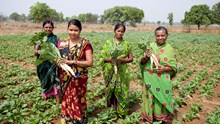
Kamalam, commonly known as dragon fruit, belongs to the Hylocereus genus. It is celebrated for its exotic appearance, refreshing taste, and significant health benefits. Among the different varieties, the pink and white pulp variants have garnered increasing popularity in India due to their ability to thrive across diverse climatic zones.
Their vibrant coloration enhances visual appeal, further boosting demand in both domestic and international markets. Thanks to IIHR’s improved post-harvest techniques, these varieties also boast a longer shelf life, increasing marketability and profitability.
IIHR's Research and Innovations
The ICAR-Indian Institute of Horticultural Research (IIHR), work on the pink and white dragon fruit in advancing the cultivation and processing of Kamalam. Here are some key areas of their research:
1. Cultivation Techniques
-
Optimized Farming Practices: IIHR has developed scientific methods to enhance the yield and quality of Kamalam. These include guidelines on soil preparation, irrigation, and pest management.
-
Climate Adaptability: Research has focused on understanding how Kamalam can thrive in various Indian climates, ensuring its viability as a crop across the country.
2. Post-Harvest Management
-
Storage Solutions: IIHR has introduced innovative techniques to extend the shelf life of Kamalam, making it more accessible to consumers.
-
Value Addition: The institute has explored ways to process Kamalam into products like juices, jams, and dried snacks, adding economic value to the fruit.
3. Training and Outreach
-
IIHR has conducted training programs, such as the 10-day course on "Scientific Approach Towards Production and Processing of Kamalam," to educate farmers and stakeholders. These programs cover everything from cultivation to marketing strategies.
The pink and white varieties of Kamalam (dragon fruit) are exceptional not only for their visual appeal but also for their nutritional profile and economic viability. Here's an in-depth look at their significance:
Nutritional Significance of Pink and White Kamalam (Dragon Fruit)
1. Rich Source of Antioxidants:
The pink and white varieties of Kamalam are abundant in antioxidants such as betalains, which help combat free radicals in the body. This reduces oxidative stress and may lower the risk of chronic diseases like cancer and heart ailments.
2. High Vitamin Content:
Kamalam is an excellent source of vitamin C, which boosts immunity and aids in collagen production for healthy skin and tissues. It also contains B-complex vitamins like B1 (thiamine), B2 (riboflavin), and B3 (niacin) that support metabolism and energy production.
3. Dietary Fiber:
Both varieties are rich in dragon fruit, promoting healthy digestion and aiding in the prevention of constipation. Fiber also helps regulate blood sugar levels, making Kamalam a suitable fruit for diabetic individuals.
4. Hydration and Electrolytes:
Kamalam has a high water content, making it a hydrating fruit, particularly useful in warm climates. It is also a source of potassium and magnesium, essential for maintaining electrolyte balance and muscle function.
5. Low-Calorie, High-Nutrition Food:
It is low in calories while being nutrient-dense, making it an excellent option for weight management without compromising on nutrition.
Economic Significance of Pink and White Kamalam (Dragon Fruit)
1. High Market Demand:
-
The exotic appeal and health benefits of pink and white dragon fruit have created a strong demand in both domestic and international markets.
-
It is particularly sought after in urban areas where consumers are more health-conscious and willing to pay premium prices for superfoods.
2. Profitable Crop for Farmers:
-
Kamalam cultivation provides high returns on investment due to its relatively short gestation period of 12-18 months and consistent yields over several years.
-
Compared to traditional crops, dragon fruit generates greater income per unit area.
3. Value-Added Products:
-
Kamalam can be transformed into value-added products like juices, smoothies, jams, and dried fruit snacks, creating additional revenue streams for farmers and food processors.
-
These products also contribute to reducing post-harvest losses.
4. Adaptability and Low Resource Input:
-
The pink and white varieties of Kamalam are highly adaptable to India's climatic conditions, especially in arid and semi-arid regions, where water resources are limited.
-
The crop is relatively low-maintenance, requiring minimal chemical inputs, which reduces production costs.
5. Export Potential:
-
With proper branding and quality assurance, Indian Kamalam can capture a larger share in the global market, competing with producers from countries like Vietnam, Thailand, and Malaysia.
6. Employment Opportunities:
-
Kamalam cultivation and processing create employment opportunities in rural areas, contributing to local economic development.
Challenges and Solutions
While Kamalam holds immense potential, its cultivation is not without challenges. Issues like pest infestations and the need for specific climatic conditions can pose hurdles. IIHR's research aims to address these challenges through innovative solutions and farmer education.
Future of Kamalam in India
With its dedication to innovation, training, and farmer support, IIHR is redefining how dragon fruit is grown and marketed in India. As more farmers adopt Kamalam cultivation, the crop is transforming livelihoods, enhancing sustainability, and contributing to a healthier population.
The pink and white Kamalam varieties are emblematic of a new wave in Indian horticulture—a fusion of nutrition, aesthetic appeal, and economic promise. IIHR’s leadership in research and outreach is paving the way for widespread adoption, increased rural incomes, and a vibrant export-ready industry. Kamalam is not just a fruit—it’s a symbol of India’s agricultural transformation.
















